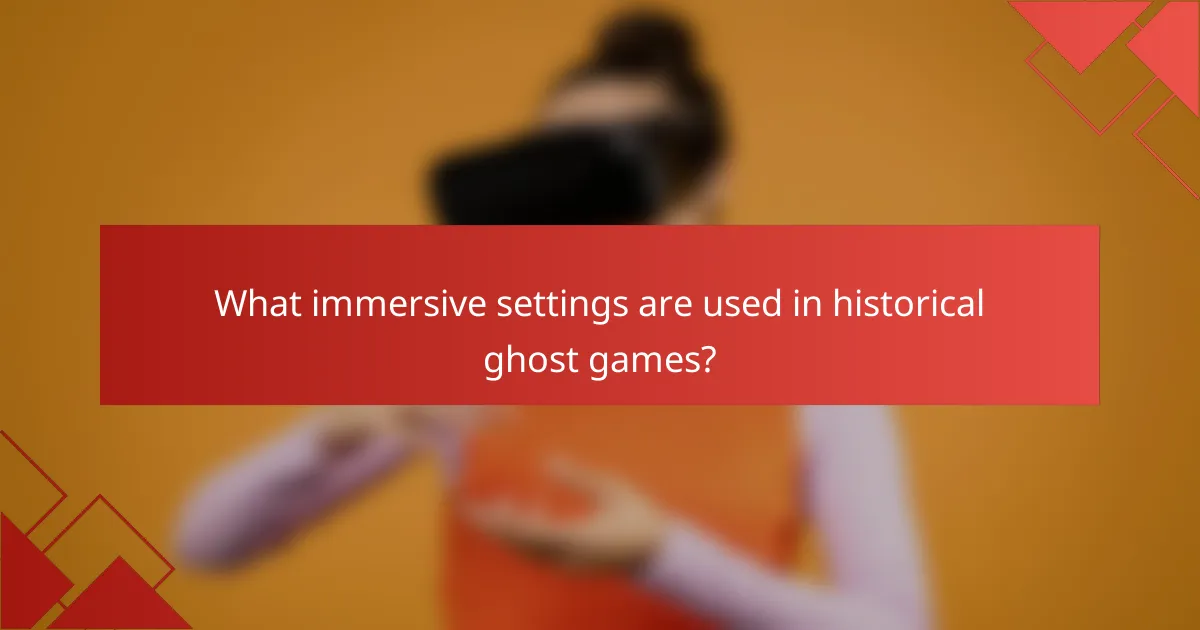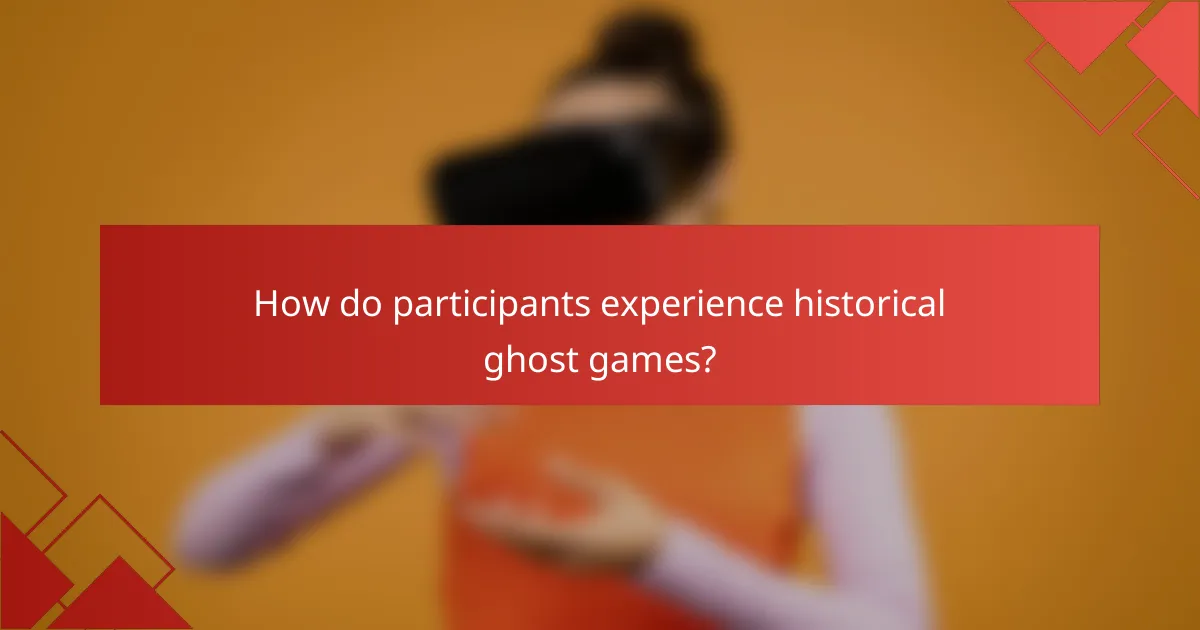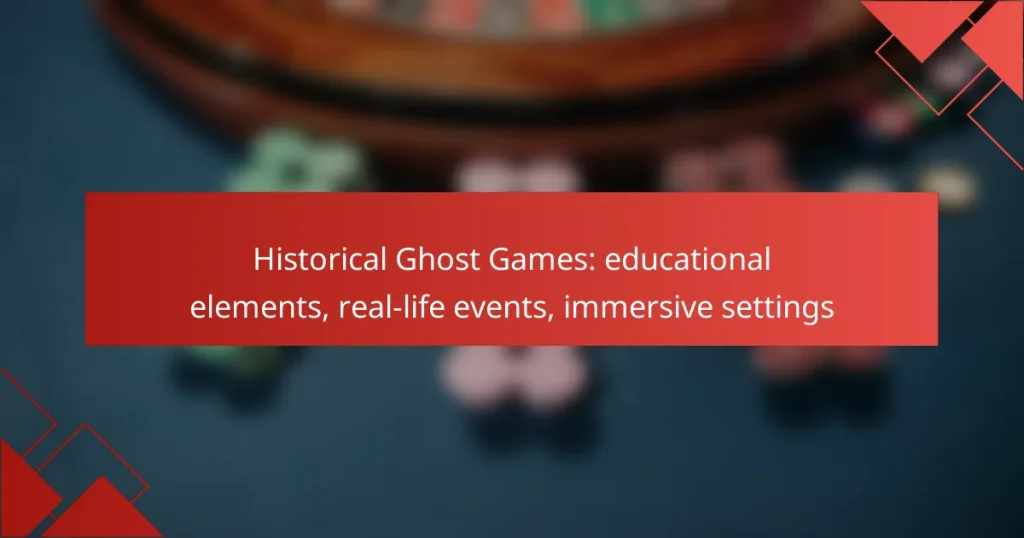Historical ghost games offer a unique blend of entertainment and education, immersing participants in the rich tapestry of history while exploring eerie tales and local lore. By drawing inspiration from real-life events, these games create captivating experiences that connect players with significant moments in time. The carefully crafted settings, ranging from historic buildings to natural landscapes, enhance the narrative and deepen the engagement with the past.

How do historical ghost games educate participants?
Historical ghost games educate participants by combining entertainment with learning, allowing players to engage with history in an immersive way. These experiences often highlight real-life events and local lore, making history accessible and memorable.
Engagement through storytelling
Storytelling is a powerful tool in historical ghost games, as it captivates participants and draws them into the narrative. By weaving together ghost stories with historical facts, players can connect emotionally with the past, enhancing their understanding of the events that shaped their community.
For example, a ghost game set in a historic district might recount tales of local figures who faced tragic fates, allowing players to explore the human side of history while navigating the game.
Interactive learning experiences
Interactive learning experiences are central to the educational value of historical ghost games. Participants often engage in activities that require them to solve puzzles or complete challenges based on historical knowledge, reinforcing what they learn through hands-on involvement.
This approach not only makes learning enjoyable but also helps to retain information, as players actively apply their knowledge in a dynamic setting.
Historical accuracy in narratives
Maintaining historical accuracy in narratives is crucial for the credibility of ghost games. Game designers often research local history to ensure that the stories told are rooted in real events, which enhances the educational aspect of the experience.
By presenting factual information alongside fictional elements, players can distinguish between myth and reality, fostering a deeper appreciation for their local heritage.
Collaboration with educators
Collaboration with educators can elevate the educational quality of historical ghost games. Many game developers partner with teachers or historians to create content that aligns with educational standards and learning objectives.
This partnership ensures that the games not only entertain but also serve as effective teaching tools, making history relevant to students and the community.
Use of local history
The use of local history in ghost games allows participants to explore their own cultural heritage. By incorporating local legends and historical figures, these games create a sense of place and identity, making the learning experience more relatable.
Players often discover new aspects of their community’s past, which can inspire further interest in local history and preservation efforts.

What real-life events inspire historical ghost games?
Historical ghost games draw inspiration from real-life events, often intertwining local history with supernatural lore. These games create immersive experiences that allow participants to explore significant moments in history while engaging with the eerie tales that surround them.
Famous hauntings in American history
Many historical ghost games are rooted in famous hauntings across the United States. Locations like the Stanley Hotel in Colorado and the Myrtles Plantation in Louisiana are known for their ghostly residents and have become popular settings for these immersive experiences. Participants often learn about the tragic events that led to these hauntings, enhancing their understanding of American history.
Local legends and folklore
Local legends and folklore play a crucial role in shaping the narratives of historical ghost games. Each region has its unique tales, such as the Headless Horseman in Sleepy Hollow or the Bell Witch in Tennessee. These stories not only entertain but also preserve cultural heritage and community identity.
Significant historical figures
Historical ghost games frequently feature significant figures from the past, such as presidents, soldiers, or activists. For instance, events centered around figures like Abraham Lincoln or Harriet Tubman can provide insights into their lives and the societal issues of their time. Engaging with these personalities through ghostly narratives can deepen participants’ appreciation for history.
Notable battles and conflicts
Many ghost games are inspired by notable battles and conflicts that shaped a nation’s history. Locations like Gettysburg, Pennsylvania, are steeped in stories of soldiers who lost their lives during the Civil War. These sites often serve as backdrops for ghost games, allowing participants to reflect on the sacrifices made and the lingering spirits that are said to remain.
Community involvement in storytelling
Community involvement is essential in the storytelling aspect of historical ghost games. Local historians, storytellers, and residents often contribute their knowledge and experiences, enriching the narratives shared during these events. This collaboration fosters a sense of community pride and ensures that the stories remain authentic and relevant.

What immersive settings are used in historical ghost games?
Historical ghost games often utilize immersive settings that enhance the experience by connecting players with real-life events and locations. These settings can range from historic buildings to natural landscapes, each offering a unique atmosphere that deepens the engagement with the game’s narrative.
Historic buildings and landmarks
Historic buildings and landmarks serve as captivating backdrops for ghost games, often steeped in local lore and legends. Players can explore sites like old castles, battlefields, or museums, where the architecture and history contribute to the eerie ambiance. Engaging with these locations allows participants to uncover stories tied to the past, enriching their gameplay experience.
When selecting a historic site, consider its accessibility and the availability of guided tours, which can provide additional context and enhance the overall experience.
Cemeteries and burial grounds
Cemeteries and burial grounds are often integral to historical ghost games, as they are places where many stories of the past converge. These settings can evoke strong emotions and provoke curiosity about the lives and deaths of those buried there. Players may encounter narratives related to local figures or events that have left a lasting impact on the community.
When planning a game in such locations, ensure that all activities respect the sanctity of the site and comply with local regulations regarding visitation and conduct.
Haunted locations in urban areas
Urban areas often feature haunted locations that are rich in history and ghostly tales. Places like old theaters, hotels, or abandoned factories can provide thrilling experiences for players. The juxtaposition of modern life with historical hauntings creates a unique atmosphere that can be both exciting and chilling.
Consider the safety of the area and the potential for noise or distractions from the urban environment when designing the game. Engaging local historians can also add depth to the narratives explored in these settings.
Natural landscapes with historical significance
Natural landscapes, such as battlefields, forests, or rivers, often hold historical significance and can serve as immersive settings for ghost games. These locations allow players to connect with the environment while learning about historical events that took place there. The natural elements can enhance the atmosphere, creating a sense of isolation or tranquility that contrasts with the ghostly themes.
When utilizing natural landscapes, ensure that participants are aware of the terrain and any potential hazards, and consider providing guidance on how to navigate these areas safely.
Virtual reality environments
Virtual reality (VR) environments offer a modern twist on historical ghost games, allowing players to immerse themselves in digitally recreated settings. These environments can replicate historic buildings, cemeteries, or urban landscapes, providing an interactive experience that can be tailored to various narratives. VR technology can enhance the sense of presence and engagement, making the ghostly encounters feel more immediate and impactful.
When implementing VR, ensure that the technology is accessible to all participants and consider offering tutorials to help users acclimate to the virtual space. Additionally, keep in mind the potential for motion sickness and provide breaks as needed.

How do participants experience historical ghost games?
Participants engage in historical ghost games by immersing themselves in narratives that blend real-life events with interactive storytelling. These experiences often involve role-playing, exploration, and problem-solving, allowing players to connect with history in a unique and engaging way.
Role-playing historical figures
Role-playing historical figures is a central element of historical ghost games, where participants assume the identities of notable individuals from the past. This approach helps players gain insights into the motivations, challenges, and experiences of these figures, making history feel more tangible.
Players often receive character backgrounds and objectives that guide their interactions within the game. For example, one might portray a famous revolutionary leader, navigating political intrigue while uncovering hidden truths about their era. This method fosters empathy and a deeper understanding of historical contexts.
To enhance the experience, game facilitators may provide costumes or props that reflect the time period, further immersing participants in the role. Engaging with other players as historical figures can lead to dynamic storytelling and collaborative problem-solving, enriching the overall experience.


